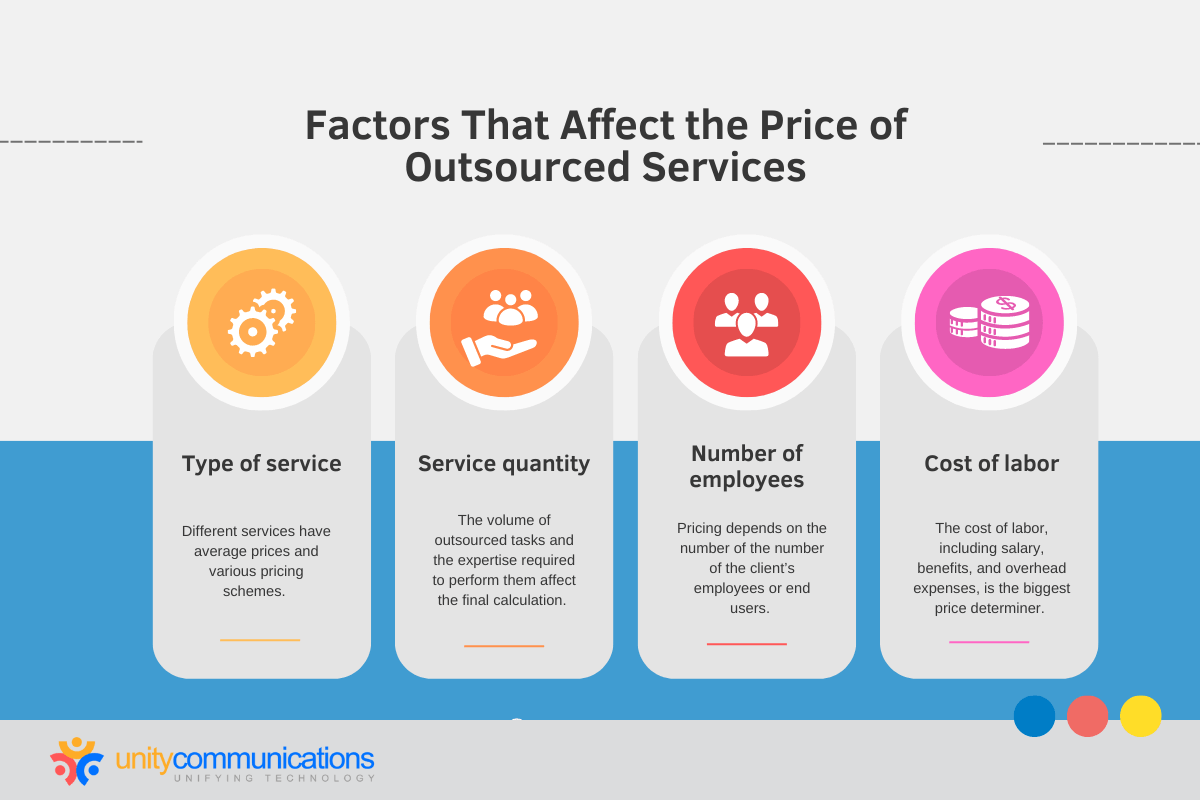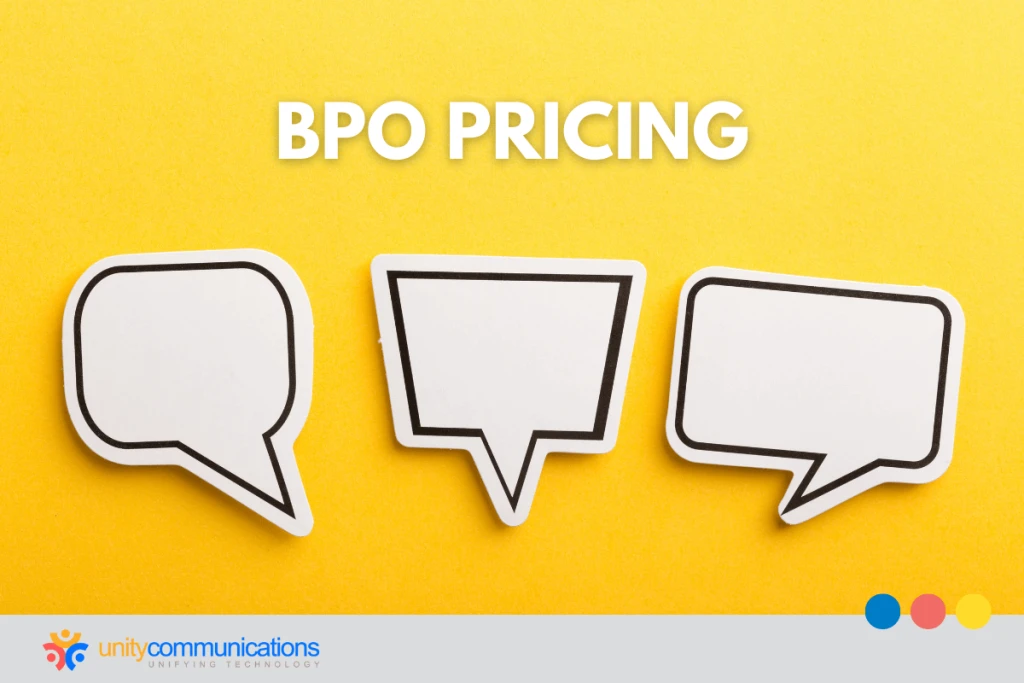Table of Contents
Business owners have many reasons to work with a business process outsourcing (BPO) company—finding the right talent or easing their in-house workload to prevent burnout. But the most compelling reason is straightforward: outsourcing reduces costs and saves money.
Saving money and reducing costs are unlike acquiring “free” services. This article defines the different BPO pricing models and their advantages, outsourcing costs, and the factors that affect the final price.
By the end of this article, business owners will know how to select the right pricing structure for their organization.
Introduction to BPO Pricing Models

When evaluating quotes from different BPO companies, it’s crucial to delve into the various BPO types and their associated pricing models. To ensure an accurate assessment, it’s essential to compare like with like.
Traditionally, outsourcing service providers offer a quote encompassing implementation costs, with clients paying a recurring monthly fee that covers ongoing expenses and labor. This model allows clients the flexibility to scale their operations based on their evolving needs, consequently affecting the monthly fee.
On the other hand, some providers employ a savings- or profit-based framework. This involves meticulous analysis of the client’s current expenses, and the service provider charges a percentage based on the savings accrued through outsourcing. This approach hinges on how effectively outsourcing enhances the client’s profits.
Alternatively, there’s the option to establish a joint venture with the client, a somewhat unconventional model that necessitates an in-depth understanding of the business and its legal implications.
Now, let’s delve deeper into the diverse BPO pricing schemes:
Fixed Price
Within a fixed pricing model, both parties mutually agree on a standard rate for the outsourced services, encompassing labor and tool payments. Payment frequency, whether monthly or annually, can be tailored to the client’s preference. Additionally, the base pricing model can undergo adjustments contingent on success targets, salary structures, and incentive programs.
Variations of the Fixed Price Model
- Fixed price with an economic price adjustment. This variation allows for price fluctuations based on cost adjustments for resources, materials, labor, and workspaces included in the fee.
- Fixed price with an incentive (FPI). This model introduces an incentive-based approach, with adjustments hinged on predefined metrics set by the client.
- FPI successive target. Similar to fixed prices with incentives, this structure incorporates gradual adjustments to the incentive amount after the project’s initial phase.
Pros
| Cons
|
Time and Materials
Time and materials, also known as the cost and materials model, are the opposite of the fixed price model. The former bills the client based on the time and resources used by the provider. This scheme is ideal for long-term outsourced projects. The vendor bids on the project and provides a proposal based on the client’s requirements.
This BPO pricing model might include a cap to control costs. The client sets a limit to prevent excessive charges and monitor the budget.
Pros
| Cons
|
Incentive-based
Clients can incorporate an incentive program into the payment scheme to further promote business goals. In addition to the standard pricing, the client might pay an additional commission or bonus to incentivize the service provider to improve performance.
This model is ideal for seasonal accounts and additional services such as an after-hours service or a 24/7 call center line. Examples of outsourced roles that use this BPO pricing scheme are the following:
- Third-party sales representatives who get a monthly or quarterly incentive for each deal won
- Outbound lead generation agents who receive bonuses when they exceed the quota by 20%
Pros
| Cons
|
Shared Risk-reward Model
A shared risk-reward model allows the service provider and the client to take responsibility for the project’s gains and losses. This model applies to jointly funded projects.
Similar to the incentive-based BPO pricing model, this payment structure comes with the usual flat rate, but both the client and the vendor share the developments and risks of the operation. A shared risk-reward model can be combined with a time-and-materials or fixed-price model.
Pros
| Cons
|
Choosing the Right BPO Pricing Structure for You

Ask yourself, “What is BPO for me, and what does it mean for my business?” You might find that your budget plays a crucial role in your decision. Explore the advantages and disadvantages of each BPO pricing model and follow the tips below to see which one suits you best.
Examine Goals and Challenges
Analyzing goals and challenges is essential when evaluating the true value of outsourcing. Ask yourself what you want to achieve. Do you need to save time, generate more profit, or improve customer service?
The right outsourcing pricing model for you depends on your answers to these questions. Choosing the right approach also depends on the challenges of achieving your goals and how the BPO provider can help.
Assess the Services Needed
Clients must check which services they need to outsource to get an accurate quote from the BPO provider. Some business owners know exactly which solution they need—whether to outsource a call center or hire a dedicated individual to manage accounts payable and receivable.
Others need help figuring out where to start. In this case, contact a reputable outsourcing provider, discuss the functions needing improvement, and ask how they can help. The BPO firm can help determine the necessary solutions and offer a quote.
Compare Current and Outsourced Costs
Compare existing costs with the proposed outsourcing fee. Suppose you want to replace an internal information technology (IT) team with an offshore team. Consider labor costs and other ancillary expenses, such as training, desk space, and leaves of absence, and then compare the amount to the cost of an external IT team.
A cost-per-seat calculation is necessary when replacing an internal call center team with an offshore one. Consider the current amount you pay each agent on average per month versus the vendor’s monthly cost per seat. Remember that some vendors charge an extra per-minute fee for time spent answering tickets.
Determining the Cost of Outsourced Services
Outsourcing costs depend on the services acquired. The price of onshore outsourcing vs. offshoring also differs. Consider the location of the service provider when calculating the final price.
Here are the typical costs for BPO solutions:
| Type of Service | Price of Service |
|---|---|
| General customer support | $9 – $25 per hour |
| Sales assistant | $15 – $65 per hour |
| Dedicated customer support | $10 – $22 per hour |
| Telemarketing services | $12 – $20 per hour |
| Lead generation services | $35 – $60 per lead |
| Cold calling services | $12 – $20 per hour |
| Market research services | Average cost: $15,000 – $35,000 |
| Survey processing services (phone survey) | $5,000 – $15,000 with an average cost of $40 per interview/survey |
| Survey processing services (mail survey) | Costs per response are between $20 and $40 |
| Admin/secretarial duties | $10 – $30 |
Factors That Affect the Price of Outsourced Services

Outsourcing helps clients save up to 70% on labor costs. Many aspects enable BPO companies to price their services at a more affordable level, including their offshore location. Moreover, several factors, including the types of outsourcing services, affect BPO pricing and the total fee that clients must pay.
- Type of service. Different services have average prices and various pricing schemes. The most common solutions are customer service, IT support, payroll, and human resources.
- Service quantity. The volume of outsourced tasks and the expertise required to perform them affect the final calculation. For example, 24/7 support, dedicated agents, and custom training are priced higher. But all these help improve customer service quality, which is crucial to 57% of customers to maintain loyalty.
- Number of employees. Solutions such as payroll software as a service (SaaS) and IT charge by the number of the client’s employees or end users. This number pertains to the individuals who use the service or software.
- Cost of labor: The cost of labor, including salary, benefits, and overhead expenses, is the biggest price determiner. The skill level and experience of the staff also affect the rates charged for their services.
The Bottom Line
Find the right pricing scheme by understanding each model, comparing quotes from vendors, and analyzing current costs versus the cost of outsourcing.
Despite its affordability, outsourcing does not compromise quality; rather, it improves the business. Companies can access high-quality, dedicated experts in accounting, IT, compliance, and more by paying less.
Let’s connect to learn more about how to get the best service at an affordable price.




